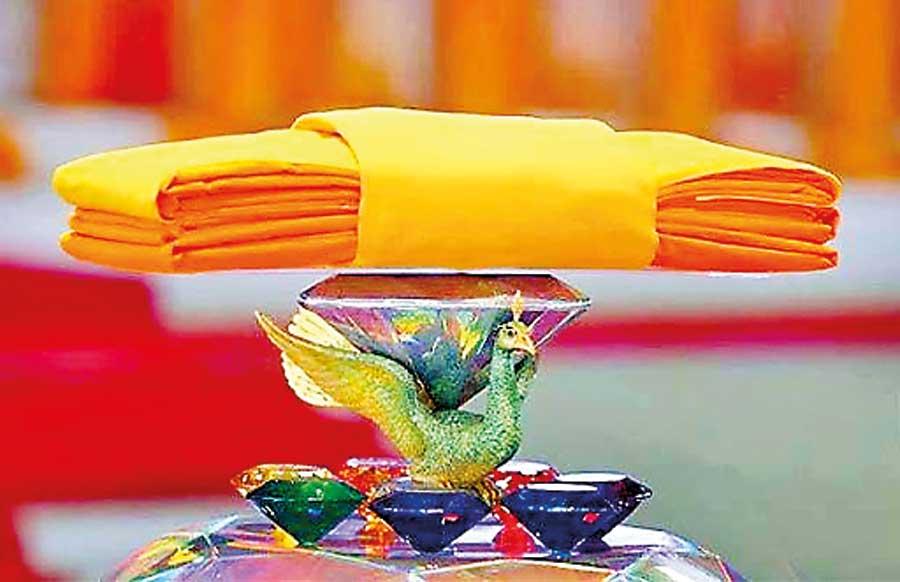30 Oct 2020 - {{hitsCtrl.values.hits}}

Katinasansaya is immeasurable and unmentionable merit acquired by the person who has offered wet season robes to a priest who had completed a period of rainy season sojourn. During the period of the rainy season - Wassana kala – Siv wanak pirisa – the company or the assembly of four kinds, viz. monks, nuns, lay male  devotees and lay female devotees accumulate merits. Katina cheewara puja or offering of wet season robes is the first of the most efficacious merits.
devotees and lay female devotees accumulate merits. Katina cheewara puja or offering of wet season robes is the first of the most efficacious merits.
In a Buddhist temple Katina cheevara puja ceremony is held only once a year and hence the opportunity to earn this kind of merit is very rare. Merit acquired by offering thick robes to Buddhist priests to be used during the wet and cold season is eternal and will never be void , result less or retribution less.
Restrictions in conducting of this year’s Katina cheevara puja due to COVID-l9, need strict health guidelines. Ceremonies will have to be conducted in keeping with precautionary measures to avoid COVID-l9 spread. Social gatherings will be confined to temple premises and all the participants have to observe health care measures, but religious rites will be performed with faith and devotion.
Why Katina cheewara puja so significant?
The word Katina has various meanings. It means hardness, roughness, sharpness, staleness, firmness and the unshaken state. The nature of merit acquired is described according to the above meanings. In the words of the Enlightened One the merit acquired by offering Katina cheewara is stable like the earth which does not tremble “Pathavireewa na jatu Kampane”, like the mountain Metamera which is supposed to be in the centre of the chakkawata which is not shaken by strong wind, gale or storm, “Na calathi Meru ruvati vayuna” or the Diamond rock which cannot be broken “Vajrameewa na bhinjane Ghanan. As such this unique act is called “Katina Pinkama.” Thanda mato” Katinana vaccati” This merit is magnanimous because the assembly of four kinds of followers, monks, nuns, lay male devotees and lay female devotees believe that this is especially efficacious in achieving total emancipation.
Efficacy of Katina Cheewara puja – character of Nagitha Thera
The efficacy of Katina cheevara puja is well explained in the character of Nagitha Thera. The merits acquired by him by offering Katina had enabled him to live in the celestial world for 18 Kalpas. On 32 occasions he was born as Sacra,Indra deva and the high or chief god. He was the Sakvithi Raja, universal sovereign, a position attained by religious devotion and second only to Gautama Buddha-ship. The merit acquired by him was sufficient for him to be born as the Universal king Sakvithi Raja on many other occasions but he had opted to forgo such chances to limit his journey in Sansara.
Efficacy of Katina Cheewara puja in a nutshell
Katinasansa or the merit of offering wet season robes to Maha Sangha is sufficient to be free from vile or evil disposition, to be born in the divine world and the world of men, to be born as Sakra, to be born as the Universal king, Sakvithi Raja, to be prosperous n all future lives, to be a leader in every future life, to be born in the divine world and never to be born in the hell or such like, to be born to high castes and never to be born to low castes, to be liked by everyone in every future life, and above all Katina cheevara puja will pave to nibbana, the cessation of all desires and of re-existence which is the goal of Buddhism.
Buddhist monks receive Katina robes during wet season
The monk in the temple is entitled to receive the Katina - the thick robe for the wet season. The monk should have completed a period of “vas” - the rainy season sojourn is entitled for the Katina. He should be well versed in the properties of conduct and should be an observer of these properties of conduct as modest, mildness, decorum, reverence, obeisance, submissiveness, religious obedience, especially in the fulfillment of the duties of the priesthood. Though only the priest receives the Katina the people in all quarters acquire merit.
Items offered during Katina Pinkama
A list of items that can be offered in a Katina pinkama is given in the book titled “Katinasansa”. It is customary to offer Pirikara-robes for a Buddhist monk. Pirikara consist of mainly “Depata Sivura”- Double robe, “Tanipata” Sivura-Single robe , “Andanaya” – under garment. However, it is usual today to offer all the eight accoutrements, viz. “Patraya”- bowl , “Andanaya” – under garment. “Depata Sivura”- Double robe, “Tanipata” Sivura - Single robe, “Patiya”- girdle, “Pihiya” – knife or razor, “Indikatuwa”- needle and “Perahankadaya”- water strainer.
“Dayakas” –donors or contributors are free to offer a piece of cloth as a “Katinaya”. In such a case the piece of cloth should be sufficient to make either an “Andanaya” – under garment, a “Depata Sivura”- Double robe, or a “Tanipata” Sivura-Single robe.
Items added to Katina by devotees
The sentence uttered by the devotees is itself an indication that various other items are included in the Katina cheevara puja. “Parivara Parikkhara saddhin imam Katina Cheevara Sanghassa dema” This Pali term means that the wet season robe is offered together with the accoutrements.
“Ata Maha Kusala”- Eight most efficacious merits
As mentioned at the beginning of this article Katina cheevara puja is the first in the list of eight most efficacious merits. A person who wishes to enter the Order should possess “Atapirikara” –eight accoutrements of a Buddhist priest. This is required also for the Higher Ordination. “Atapirikara puja”is the second most efficacious merit. “Avasa puja”- offering of monasteries is the third most efficacious merit. Buddhist monks need shelters in order to avoid pestering or harassment caused by pests and mosquitoes and to avoid the ill effects of natural causes such as the heat of the sun, cold and rain.“Sangika Dana”or offering of alms to the priesthood including the Buddha -“Buddha pamukhassa Sanghassa” is the fourth of the most efficacious merits. “Offering of Dharma books “Dharma Lekhana”, offering of land “khetta dana”, offering of Buddha statues“Buddha rupa,” “Patimakaranaya”and offering of “Vajjikuti” Toilets for the use of the clergy are the fifth, sixth, seventh and the eighth most efficacies merits respectively. During the “Cheevara Masa” or the Katina puja month all these efficacious merits are acquired by us in the temples.
Robe presented as Katina Cheevara to be tattered yellow cloth
The robe is a tattered yellow cloth. This is stitched not to suit the body size of any individual but in a way to be used by a monk of any age or any physical size. On His way to Dhakkhinigiriya the Enlightened One while passing Magadha track of Paddy fields. had shown the terraces and divisions in the Paddy fields to Ananda Maha Thera and told that the cloth should cut and stitched in the manner in which the Paddy fields are connected.
Parts of Katina cheevaraya
Katina cheevaraya consists of an odd number of parts, usually five or seven. These parts are called “Athu.” The part at the centre is “Vas Athu” and the parts on either side are “Ela Athu”. Borders, about six inches wide are “Nuwawa Athu” These parts or Athu are separated by stitches known as “Kap Bindu”
There is a custom according to which it is not proper for the clergy to obtain Katina cheevara on request. “Matarampi, Pitarampi na vattati”. This means that Bhikkhus should not “Katina” at request even from the mother or the father. It should get manifest itself from voluntary sources.
All night Pirith chanting and procession - Katina Perahera
At night on the day before the Katina puja day all night Pirith chanting pinkama is performed. Pirith is chanted throughout the night. The procession which we call Katina Perahera is started during the last quarter of the night from the temple and is proceeded to the chief dayaka’s residence. The Perahera parades the streets and in the procession dayakas carry with them various items such as Tea leaves, Sugar, Medicinal herbs, bedspreads, pillows and brooms. In the procession the Katina is carried under a canopy with all respects amidst cries of “Sadhu Sadhu” by the devotees.
Kapruka
On the previous day devotees take the items of offering to the temple and hang them on an artificial tree which is called the “Kapruka” meaning the celestial tree in the divine world which gives whatever is desired. In some parts of the country “Katina” is carried by an elderly person, keeping it on his head. In certain other areas it is tied to a pestle and is carried by a boy or a young man. Entering of the procession to the temple premises coincides with the ending of the pirith chanting. Katina cheevara is often kept in the residence of another devotee and preceded to the temple in the eve of offering it to the Bhikkhu.
Social aspects of Katina cheevara puja
Whether the Katina cheevara is prepared for offering, whether it is a ready-made robe or a piece of cloth it is customary to bring it to the temple with faith and devotion early in the morning to be offered to the Maha Sangha. The term “early in the morning” is described as the dawn when stalks of leaves in Jak trees are hardly visible.
Participation and cooperation
Nowadays devotees do not confine the Katina cheevara to one item such as a single robe, double robe, underwear or a piece of cloth. Katina cheevara is offered with all the eight accouterments or articles required by a Buddhist monk. Devotees even go beyond by adding various other items required by the village temple and the monks residing there. They make this an occasion to effect renovations to the temple including the buildings and he premises. Almost all the villagers take part in the Katina Pinkama and it takes the form of a social gathering. For the purpose of convenience a chief donor or Dayaka is appointed with the consent of all the villagers.
In some temples Katina Puja Pinkama is started ten or twelve days in advance. Dharma sermons are conducted daily in the evenings and a large number of devotees come to the temple to listen to the Dharma sermons and to attend to religious rites.
First Katina cheevara puja in Sri Lanka
Arahant Mahinda Maha Thera arrived in Sri Lanka with four other Arahants, Arahant Sanghamitta Theri’s lay time son, Sumana Samanera and Bhanduka upasaka. Bhanduka upasaka, grandson of Mahinda Maha Thera’s aunt was ordained and attained Arahantship on the second day after the arrival of the delegation. In chronicles it is stated that Arahant Mahinda Maha Thera arrived at Chetiyagiriya on the seventh day for the rainy season sojourn at Mihintale. There were sixty two Bhikkhus for the rainy season sojourn. King Devanampiyatissa’s renouned 68 caves around Kantaka chetiya were there for the rainy season sojourn of sixty two Bhikkhus. This is the first Katina cheevara pinkama in Sri Lanka.
27 Nov 2024 2 hours ago
27 Nov 2024 3 hours ago
27 Nov 2024 3 hours ago
27 Nov 2024 3 hours ago
27 Nov 2024 3 hours ago